Friday, December 5, 2008
The Car Enthusiasts Gift Guide
Regardless of whether you give gifts for Christmas, Chanukah, or Kwanzaa, you have just a couple of weeks left to get your shopping done. Or, if you're like us, you have only a couple more weeks to make sure those around you have fully absorbed your heavy hints about what you really want this year. In case your loved ones regard you as one of those guys who has everything (meaning there is nothing left to buy you), we've assembled a little list to remind them that you indeed do not have it all just yet.

carplanetdetailing.com, from $10
Car Planet's line of enviro-friendly car-care products is "green" even without wrapping paper or bows. The company's founder, a successful car-wash business owner, kept running into environmental issues when trying to open new locations. As a result, he formulated a line of professional-quality cleaners that are biodegradable and non-toxic.
The lineup currently includes a car wash, wheel cleaner, glass cleaner, all-purpose cleaner, tire dressing, and rain repellant. Despite being easy on their surroundings, they are all extremely effective. Car Planet's Tire Shine (which really isn't shiny at all) is particularly impressive, leaving clean tires with a rich, natural finish. In the near future, the company plans to extend its line to include paint cleaners and waxes, as well as interior cleaners and conditioners.


wrenchwareinc.com, from $19 per 3-piece set
They are kitschy, and more than a little tacky, but what else says "gearhead" more than drop-forged stainless flatware with open-end, box-end, or adjustable wrench ends for handles? How about a genuine piston-cup coffee mug? Perhaps a wine glass with an exhaust valve for a stem and a gear for a base?
Wrenchware is perfect for the guy who literally eats, drinks, and sleeps in the garage — no longer will the family serviceware end up out there. Now they just need to come up with butter knife that actually works as a screwdriver.

gmpdiecast.com, $99
Be honest with yourself — you will never own a Ferrari Enzo. Don't worry, neither will we. But that doesn't mean you can't daydream at your desk once in a while. GMP Diecast has built a dead-accurate 1/6th-scale replica for your desktop. Available in either Corsa Rosso or Fly Yellow, the miniature dash is mounted on turned aluminum posts. With the flip of a switch, the instrument cluster lights up to show you a tachometer and speedometer that, sadly, will always rest at zero.

garagescenes.com, from $399
If your garage is your sanctuary, perhaps it's time to upgrade the scenery. Garage Scenes prints some of the coolest automotive imagery on seamless sheets of heavy-duty vinyl for you to mount on your garage walls. From iconic Route 66 locales to black-and-white shop scenes of the original Carroll Shelby garages, these murals will put a smile on your face every time you park your car.
FFor around $400, you get a piece of automotive art measuring nine and a half feet by more than six feet. Some pieces are even larger, measuring up to 11 by nine feet. The collection of photography, which includes gas stations, driving roads, drag racing, and vintage and modern racing scenery, is breathtaking. But perhaps not as awe-inspiring as the licensed Shelby Works photos, which show numerous Cobras and Daytona coupes in various states of hand construction. Hang one of these prints in your stall and you'll soon be the talk of the neighborhood.

graphicsexpress.com, from about $30
If you can't swing four bills to dress up your garage, perhaps a few selective bits of "petro-mobilia" can give you a similar effect. Graphics Express manufactures high quality steel reproductions of vintage oil-company signage. Mobil, Polly, and Gilmore are all authentically represented on everything from 12-inch round to mammoth 30-inch signs.
The company also does Route 66 shields for each of the eight states the Mother Road once passed through. For a more authentic display, go for the distressed look with optional bullet holes and rust.

madmaps.com, from $7
The Regional Touring Series ($12 each) includes 25 to 40 scenic drive routes for each region of the country (24 in total), and is a great way to discover new and interesting places when traveling. The Get Outta Town Series ($7 each) features five to seven scenic drives that take you away from the hustle and bustle of the nation's 25 largest metro areas — perfect for a last-minute weekend getaway.
The Regional Touring Series ($11.99 each) includes 25 to 40 scenic drive routes for each region of the country (24 regions total), and is a great way to discover new and interesting places when traveling. The Get Outta Town Series ($6.99 each) features five to seven scenic drives that take you away from the hustle and bustle of the 25 largest metro areas in the country — perfect for a last-minute weekend getaway.

piloti.com, $160
Maybe you like the idea of a driving shoe you can wear to work, but you've always felt the brightly colored Pilotis of the past were just a bit too loud for your taste. The Prova CL is a more grown-up shoe that you can wear to the office, even when it's not Casual Friday.
A mid-top design, the Prova CL is made of butter-soft leather and looks particularly stunning in the vintage cuio (Italian for leather) finish. Naturally, it features Piloti's patented roll-control heel for comfortable footwork and the signature Piloti tire-tread sole for everyday comfort.


bentleypublishers.com, $275
There are books about Porsches, and then there are books about Porsche. This limited edition hardcover (500 will be printed) is the definitive chronicle of Dr. Porsche's early engineering achievements, before he made history with the KdF-Wagen and his own sports cars.
In addition to more than 570 images and wonderfully illustrated cutaways of early Porsche cars, the 496-page book also shows original sketches created by Herr Doktor.

randolphusa.com, from $99
Randolph Engineering may not be the first name to come to mind when you think of aviator glasses — unless you're an Air Force pilot. Since 1977, Randolph has been supplying aviation crew glasses to the military, and they're now available to the public as well.
Less than a hundred bucks gets you a pair of green-tinted lenses in black, silver, or 24K gold-plated frames. For another $40, you can upgrade to gray polarized lenses, and there's no charge for choosing bayonet, skull, or cable temple styles. As you'd expect from a product built to military specs, the lightweight construction is top-notch, with double-hinged arms. They're perfect whether you consider yourself a Maverick or merely an Ice Man.
Posted by Chismillionaire at 3:39 PM 1 comments
Medical Marijuana Now Legal In Michigan, But Rules Unclear
DETROIT — Medical marijuana became legal in Michigan on Thursday, but smoking a joint could still get patients arrested because the regulations needed to protect them won't be ready for months.
The law approved by voters in November allows patients with cancer, HIV, AIDS, glaucoma and other diseases to use marijuana to relieve their symptoms on a doctor's recommendation.
Qualifying patients can register with the state and receive ID cards allowing them to legally acquire, possess, grow, transport and use a limited amount _ no more than 2.5 ounces and 12 plants _ of marijuana. They also can designate a primary caregiver to receive similar protection.
But those cards won't be issued until the Department of Community Health introduces guidelines addressing how applications will be handled, what fees will be charged and other issues. The rules must be finalized by April 4.
Until then, anyone possessing marijuana _ even patients who could later qualify for the program _ can be arrested and prosecuted, though the law allows patients to use a medical-justification defense at trial.
"We have this void where this takes effect now, but there are no rules, regulations or guidance for the people who want to use it or the people who enforce the laws," said Jim Valentine, chief of police in Lowell and first vice president of the Michigan Association of Chiefs of Police.
Officers in Lowell will arrest marijuana users even if they claim to be patients awaiting cards, Valentine said. He said he'll let the prosecutor decide whether to pursue charges.
A medical-marijuana program nearly identical to Michigan's was implemented without major incident in Rhode Island in 2006, said Charles Alexandre, who oversees the program as chief of health professions regulation in Rhode Island's Department of Health. That state also had a period where the law went into effect before the regulations were in place, and patients simply had to wait until the rules were in order.
"It's been very quiet," Alexandre said.
Michigan is the 13th state to allow medicinal use of marijuana, though the state's law doesn't address how patients can obtain it. It's illegal to sell marijuana, even to registered patients. That's also the case in several other states.
Police in Michigan say they want guidance on the issue, and some experts said the Legislature may have to intervene if that or any other aspect of the program becomes a problem.
Posted by gjblass at 2:47 PM 0 comments
Labels: Chicago News, Medical Marijuana, Michigan Marijuana Laws, Michigan Medical Marijuana, Michigan Pot Laws
Follow Up: Roku offers 15,000 films for $100
This could be a duplicate post, but this is the future of media, so it deserves another mention for the holidays!
It's the All-Digital Future — $100 Netflix Box Streams 15,000 Films
At the start of 2008, the Web-streamed movie experience still felt like a half-baked preview of its potential. Digital delivery required expensive hardware, and you paid extra for each rental (cough, Apple TV ... cough, Vudu). It wasn't the future we'd hoped for. Then came Roku's Netflix Player, the $100 video box that could summon more than 15,000 titles at no charge for Netflix subscribers. It was a revelation, wherein we learned what streaming video was supposed to feel like: nothing. That nothing changed everything. So go ahead, tear through all four seasons of The Office on a whim (then the original British version for good measure). Watch Strays because there's nobody home to exercise a Vin Diesel veto. For movies you can't stream, you still get your little red envelopes. And the same Roku box you love now will support hi-def streams when Netflix offers them. This little treasure chest is the real thing, straight from the all-digital future. Full review of the Roku Netflix PlayerPosted by Chismillionaire at 2:44 PM 0 comments
Filmmaker Plans to Install Camera in his Eyesocket
Rob Spence looks you straight in the eye when he talks. So it's a little unnerving to imagine that soon one of his hazel-green eyes will have a tiny wireless video camera in it that records your every move.
The eye he's considering replacing is not a working one -- it's a prosthetic eye he's worn for several years. Spence, a 36-year-old Canadian filmmaker, is not content with having one blind eye. He wants a wireless video camera inside his prosthetic, giving him the ability to make movies wherever he is, all the time, just by looking around.
"If you lose your eye and have a hole in your head, then why not stick a camera in there?" he asks.
Spence, who calls himself the "eyeborg guy," will not be restoring his vision. The camera won't connect to his brain. What it will do is allow him to be a bionic man where technology fuses with the human body to become inseparable. In effect, he will become a "little brother," someone who's watching and recording every move of those in his field of vision.
If successful, Spence will become one of a growing number of lifecasters. From early webcam pioneer Jennifer Kaye Ringley, who created JenniCam, to Microsoft researcher Gordon Bell, to commercial lifecasting ventures Ustream.tv and Justin.tv, many people use video and internet technology to record and broadcast every moment of their waking lives. But Spence is taking lifecasting a step further, with a bionic eye camera that is actually embedded in his body.
"The eyes are like no other part of the body," says Spence. "It's what you look into when you fall in love with somebody and [influences] whether you trust someone or not. Now with a video camera in there, it will change how people see and perceive me."
It's an interesting and innovative idea, says Yonggang Huang, a professor in the departments of civil and mechanical engineering at Northwestern University. Huang, along with University of Illinois professor John Rogers has developed a web of micro-sensors to enable eye-shaped cameras. Huang is not involved in Spence's project.
"It's very clever," says Huang of Spence's quest. "It is not a true eye but it provides the way for people to record images in life as they see [them] and store [them]."
Spence lost his right eye at 13 while playing with his grandfather's gun on a visit to Ireland. "I wanted to shoot a pile of cowshit," he says. "I wasn't holding the gun properly and it backfired, causing a lot of trauma to the eye."
This short video by Rob Spence shows the operation in which surgeons removed his sightless eye. Warning: Graphic imagery may be unsettling to many viewers.
After the accident, he returned to Belleville, a small town two hours east of Toronto, where he grew up. Spence became technically blind in the eye, and over the years, his vision deteriorated completely. Three years ago he had his eye removed and a prosthetic one inserted. Ever the filmmaker, he even made a movie out of his surgery. But it wasn't an easy decision.
"When you completely lose an eye it is a difficult thing to let go of," he says. "The eye has an emotional attachment. It is a window to your soul."
Spence wore an eye patch for a while, which he says looked cool. But once he started thinking about having a camera in his eye, Spence got in touch with Steve Mann, a professor at the University of Toronto. Mann is one of the experts in the world of wearable computing and cyborgs -- organisms that blend natural and artificial systems.
"There are a lot of challenges in this," says Mann, "from actually building a camera system that works, to sending and receiving images, to getting the correct shape of the camera."
Even in the age of miniaturization, getting a wireless video camera into a prosthetic eye isn't easy. The shape of the prosthetic is the biggest limitation: In Spence's case, it's 9-mm thick, 30-mm long and 28-mm high.
While that might seem like plenty of room in an age when digital cameras are squeezed into unimaginably slim and compact phones, it actually isn't. The average area available inside a prosthetic eye for an imaging sensor is only about 8 square mm, explains Phil Bowen, an ocularist who is working with Spence. Also, a digital camera has many more components than the visible lens and the sensor behind it, including the power supply and image-processing circuitry. Getting a completely self-contained camera module to fit into the tiny hollow of a prosthetic eye is a significant engineering challenge.
That's where Professors Huang and Rogers' research could come in handy. Three months ago, the duo published a paper that showed how a new sensor built out of a flexible mesh of wire-connected pixels could replace the traditional flat imaging chip as the light sensor for a camera. The mesh is made from many of the same materials as a standard digital-camera sensor, but it has the ability to conform to convoluted, irregular surfaces -- like the back of a synthetic eyeball.
"Our cameras might more naturally integrate with a prosthetic eye, due to their hemispherical shapes," says Rogers. "One might also argue that they can provide a more human-like perception of the world."
Then there's the question of how the prosthetic eyeball (the outer shell for the camera) will be made. The eyeball chassis has to close shut and be watertight.
Traditional prosthetic eyes are single pieces made with polymethyl-methacrylate (PMMA), a flexible polymer that is also used in dentures. To fit a camera in, Bowen redesigned the prosthetic eye into two pieces that could snap shut.
But with a camera inside there's something new to worry about. The modified prosthetic eye will be heavier than traditional ones and that could affect the eye socket, says Bowen. "The weight might stretch out the lower lid," he says, potentially disfiguring the face.
Assuming the size, weight and water-tightness issues can be solved, Spence has a vague idea of how he thinks it can work. A camera module will have to be connected to a transmitter inside the prosthetic eye that can broadcast the captured video footage. To boost the signal, he says he can wear another transmitter on his belt. A receiver attached to a hard drive in a backpack could capture that information and then send it to another device that uploads everything to a web site in real time.
If it sounds rather cumbersome and complicated, it is. Spence and his team are still working to find the right answers.
He hasn't been able to get the bigger camera companies to work with him. "Part of problem is if you cold call somebody it sounds like there is a maniac on the other end of the phone," he says. "This whole idea confuses and overwhelms most people."
"Right now I am begging, borrowing and stealing camera modules from different cameras to make a stage one prototype," says Spence.
Spence is not the only one attempting to implant a video camera in his eye socket -- artist Tanya Vlach is working on a similar project -- but if he's successful he will be more than just another cyborg. The documentary film he's making about his efforts, plus the experience of living with a video camera in his eye, could help build greater awareness about the culture of surveillance in our society today, he says.
"No one is going to ban surveillance cameras," says Spence. "It's more about being aware of it. It's about giving a shit in the first place."
Having a bionic eye doesn't mean Spence will be recording all the time, he says. Unlike lifecaster Justin Kan, Spence is not promising to broadcast all of his life's moments. (Even Kan reneged on his promise within a few short months, as soon as a romantic opportunity presented itself.)
Spence is willing to turn off his camera in spaces such as gyms, theaters or private events. But he will be making many of those decisions on the spur, every day. "I wouldn't behave that differently than someone with a cellphone today," he says.
Even though his project is still in its early stages, Spence says many people have already told him they wouldn't be comfortable being filmed.
"People are more scared of a center-left documentary maker with an eye than the 400 ways they are filmed every day at the school, the subway, the mall," he says.
He hopes he will help get people thinking about privacy, how surveillance cameras and the footage they record are being used and accessed.
"Sometimes I run a little experiment," he says. "I tell people around me, 'Did you know there are 11,000 new video cameras being installed in our country every day?' Then I will exaggerate and say there are 50,000 new video cameras going in everyday," says Spence. "Most of the times I get the same answer: 'That's interesting. Now what's for lunch?' or 'The weather is nice today.'
"I wonder what those people will say when they are staring back into the video camera in my eye?"
Posted by Chismillionaire at 2:42 PM 0 comments
Salt Water Crops May End Land Crisis Debate
Saltwater-loving plants could open up half a million square miles of previously unusable territory for energy crops, helping settle the heated food-versus-fuel debate, which nearly derailed biofuel progress last year.
By increasing the world's irrigated acreage by 50 percent, saltwater crops could provide a no-guilt source of biomass for alt fuel makers and tone down the rhetoric of U.N. officials worried about food prices, one of whom called the conversion of arable land to biofuel crops "a crime against humanity."
While growing crops in saltwater has been on the fringes of horticulture for decades, the new demand for alternative energy has pushed the idea onto the pages of the nation's most prestigious scientific journal and drawn the attention of NASA scientists.
Citing the work of Robert Glenn, a plant biologist at the University of Arizona, two biologists argue in this week's Science that "the increasing demand for agricultural products and the spread of salinity now make this concept worth serious consideration and investment."
Glenn has been arguing for the value of all kinds of saltwater farming to a small but growing audience for nearly thirty years, but it is the demand for biomass to turn into fuel that brought NASA calling. His team's report for the agency estimates that salt-loving crops could be used to produce 1.5 billion barrels of ethanol annually on a swath of new agricultural land almost five times the size of Texas.
"I'm convinced that saltwater agriculture is going to open up a whole new expanse of land and water for crop production," Glenn said. "Maybe the world hasn't needed a 50 percent expansion in irrigated agricultural land because we've had enough food, but now that biofuels are in the mix, I think it's the way crop production should go."
The world's population has grown by five billion people since 1900 to an astounding 6.7 billion today. Despite the population explosion, food production — primarily animal feed and commodity cereals like wheat and rice — has been able to keep pace. But the food system has been severely stressed by a variety of factors, including the increasing use of arable land to grow energy crops to turn into biofuels.
Even if energy crops didn't cause all or even most of the precipitous rise in food prices in 2007, most social and environmental groups agree that the best location for bioenergy crops would be on currently unusable land. That would ensure that land used to grow food crops in poor countries wasn't converted to growing energy crops to power cars in developed nations.
A key question has remained, though: where exactly will humans find a whole bunch of unused land that is still good for growing crops?
 Overly salty land could play a large and previously underappreciated role. That's because there's plenty of previously uncultivated territory in the world's coastal deserts, inland salty soils, and over-salinized agricultural land.
Overly salty land could play a large and previously underappreciated role. That's because there's plenty of previously uncultivated territory in the world's coastal deserts, inland salty soils, and over-salinized agricultural land.
After taking into account environmental protections and other factors, Glenn's report estimates that 480,000 square miles of unused land around the world could be used to grow a special set of salt-tolerant plants — halophytes. Glenn's team calculated that this could produce 1.5 billion barrels of oil equivalent per year. That's 35 percent of the United States' liquid fuel needs.
Halophytes thrive in saltwater. While salt damages most plants, these salt-loving plants actually use the saltwater to draw in fresh water. In essence, they make themselves saltier than the surrounding water, which, through osmosis, drives fresh water into the plant.
These plants are attractive candidates for both food and fuel because they have very high biomass and oil seed yields. The Science authors note that one leading halophyte-candidate, Salicornia bigelovii, produces 1.7 times more oil per acre than sunflowers, a common source of vegetable oil.
"[Some halophytes] yield even more than things like switchgrass and they'll be grown on land that's just not used right now," said Glenn.
Of course, turning halophyte biomass into fuel will require further cost reductions in the production of biofuel from cellulose. Research into cellulosic ethanol continues around the world at a breathtaking pace and many industry observers expect the next five years to yield enough breakthroughs to make the technology economical.
Halophytes could also be part of the solution to another environmental problem: heavily-salinated wastewater from large farms. Right now, that water is dumped into manmade wetlands. For example, in California, the Imperial Valley authorities dump their salty water into the Salton Sea.
"That's a huge ecological problem waiting to happen," said Glenn.
After absorbing 80 years of agricultural runoff, the Salton Sea is 25 percent saltier than the ocean, and is facing serious ecological problems. Instead of pumping salinized water into these wetlands, the farms could capture that wastewater and use it to grow halophytes. Already, Sharon Benes, a plant scientist at Fresno State, has been planting test plots in the San Joaquin Valley.
But even if halophytes can help solve some of the world's environmental problems, Glenn is realistic about the difficulties of changing agricultural systems.
"I started in aquaculture back in the early 70s and we thought, golly, aquaculture is going to save the world. Looking back, it's been 35 years, but over half of the key fisheries products come from aquaculture, it just took longer than people thought," Glenn said. "I think it's the same thing with saline crop production."
Citation: "Crops for a Salinized World" by Jelte Rozema and Timothy Flowers. Science, doi 10.1126/science.1168572
Image: Salicornica bigelovii and Salicornica virginica growing in Galveston, TexasPosted by Chismillionaire at 2:41 PM 1 comments
Sperm donor fathers 46 children
"I do it because I know how hard it is for people who desperately want a child," said Ed Houben, a tourism guide from Maastricht.
One of the reasons Houben is so popular, he said, is because many men stopped donating sperm three years ago when the United Kingdom said donors no longer could remain anonymous, The Sun reported Monday.
As a result, British women are going to other countries to find a sperm donor or having sperm samples sent to them, said Houben, noting women find out about him through the Internet and through word of mouth.
Houben, who said he's never had sex with any of his children's mothers, recently held a party at his home for his children and their families.
"The kids had the chance to play with their half-brothers and sisters, which was nice, said Houben.
Posted by gjblass at 2:37 PM 0 comments
Labels: Medical, Strange News
Just Think ‘007’ and Add $269,993

2009 Aston Martin DBS.
By LAWRENCE ULRICH
STARTING in 1965 with the DB5 in “Goldfinger,” Aston Martin has been linked at the tuxedoed hip with James Bond; gadget-packed Astons have been driven by Connery, Lazenby, Dalton, Brosnan and Craig.
But given the economy, anyone who can still afford a $270,000 Aston Martin DBS might inspire a real-world film, with enough supervillains and world domination to make 007 quiver. Call it “The Man with the Golden Parachute.”
Wafting above the crowd is certainly the point. With 510 burbling horsepower from the V-12 power plant, angry stockholders vanish in the mirror. Seething mobs of the unemployed are drowned out by the 1,000-watt Bang & Olufsen sound system.
The shift lever is placed a bit too far rearward on the console for ideal shifting, but the lever itself is easy and precise.
C.E.O.-envy aside, the roughly 300 Americans who will drive home a DBS this year need to know the score. First, ignore the self-appointed accountants who have questioned why the DBS costs $100,000 more than the Aston DB9. I mean, these people drive Hondas.
The DBS and DB9 share a lightweight aluminum chassis and the 5.9-liter engine block under their stretched hoods. But the DB9 has been around six years, a virtual eternity for people who want the latest and greatest. Second, the lovely DB9 — designed by Ian Callum before he cribbed from himself to create the Jaguar XK — looks even more Jaglike next to this muscled-up Adonis.
The DBS isn’t just one of the world’s prettiest cars. It pulls off the tricky feat of looking insanely fast and expensive without rubbing everyone’s nose in it. For all its power — a 4.2-second eruption gets you to 60 m.p.h.; top speed is 191 — the Aston is a classic GT, a proper Brit with a noblesse oblige you won’t find in a flaming yellow Lamborghini.
That Aston heritage dates to 1914, but it took Ford to revitalize the moribund company. After 13 years of full ownership, Ford sold out last year to a consortium backed by Kuwaiti oil investors and led by David Richards, a British motorsports entrepreneur.
I spent my first day with the DBS balancing euphoria with skepticism. I figured it would drive like any traditional Aston: a buttery high-speed cruiser with a concert-hall V-12, but too soft and gentlemanly to sully itself on twisty roads.
Instead, after a warm-up, the Aston sliced through the countryside like an English football hooligan, but with a better singing voice.
A dashboard switch maxes out the computer-controlled shocks for high-speed duty, keeping the Aston’s body pinned to the ground like a manhole cover. The standard ceramic composite brakes — which can cost up to $15,000 extra on other exotic cars — could stand a bit more initial bite, but were triple-espresso strong.
An honest-to-God manual shifter — increasingly rare in cars of this caliber — amplified the fun. The lever is placed a bit too far rearward for ideal shifting, and the clutch’s iffy take-up requires practice for smooth starts. But the lever itself is easy and precise, topped with a slab of cool metal. A paddle-shifted automatic is an option.
Then there’s that engine, which sounds like money being torn in two. A valve in the exhaust system cocks open under heavy throttle to release the battle cry of the V-12. On that note, the DBS got a dismal 12 m.p.g.
On this car, pretty much everything that isn’t lightweight aluminum is even more expensive carbon fiber, from the featherweight hood and interior door trim to the angry-looking aerodynamic diffuser at the rear. It adds up to a relatively svelte 3,737 pounds, about 100 fewer than the main competitor, the $310,000 Ferrari 599 GTB Fiorano.
Swan doors swing open on a slightly upward angle, clearing curbs that would gouge the typical low-slung sports car. High sills make for body-scrunching entry and exit, but it’s worth it once you’re inside. Semi-aniline leather and a suede headliner were a perfectly matched deep red, making the cabin look like a boutique bordello.
Gauges look as fine as a Swiss chronograph. But while I’ve gotten used to the strange tachometer that spins counter-clockwise, there’s still no red line to show peak engine speed. How much could it cost to paint a red stripe on that thing?
Other nitpicks, just to make clear that I’m not a total sucker for beauty: lumbar controls are buried between the seats and console in a “Where’s Waldo?” arrangement. A cheap-looking navigation screen rises from the dash like a ghoul from the crypt of Kia. And the key is called the Emotion Control Unit, which is appropriate since it forced me to keep my temper in check. This fiddly chunk of genuine sapphire and stainless steel must be inserted into a slot just right or the car won’t start.
There’s a small parcel shelf in the rear but owners can opt for a tiny back seat instead — for children who haven’t been sent to boarding school.
Buyers seeking unrivaled GT performance may choose the 612-horse Ferrari. The 599 GTB is decisively faster than the Aston and its handling is a bit purer. But in my view, the 599 GTB — which even zealots wouldn’t cite as an all-time great Ferrari design — can’t beat the Aston’s looks.
Such fantastical comparisons tend to embarrass me anyway; it’s like asking which superhero would make the best and fastest sushi chef. (My money’s on Aquaman.)
Still, most car fans, including auto writers, keep a fantasy list of cars we imagine we’d buy if we struck it rich. For what it’s worth, the DBS is the first Aston GT to make it onto my mental bedroom wall. Surely there’s no harm in wondering how much a used DBS will fetch in 10 years.
Posted by gjblass at 2:35 PM 0 comments
Labels: 007 Cars, Aston Martin
Judge Rules in Favor of Cuba Tobacco
Chismillionaire says- Rightfully so because every Dominican re badge of a Cuban name is absolutely shit!
 |
Cubatabaco, the arm of the Cuban government that owns Cuba's cigar trademarks, had appealed to the United States District Court, Southern District of New York, citing a prior Court of Appeals ruling (ITC v. Punchgini) as a basis for its claim against General Cigar, the producers of the Dominican Cohiba cigar sold in the United States. After reviewing Empresea Cubana Del Tabaco v. Culbro Corp. (Culbro being the former owner of General Cigar), Judge Robert W. Sweet determined on November 18 that General Cigar was guilty of unfair trade by misappropriation. Furthermore, Sweet ruled that Cubatabaco was entitled to relief.
General Cigar's spokesperson said company officials were not available to comment. General is a subsidiary of Swedish Match AB.
The litigation goes back 11 years since General Cigar began marketing products with the Cohiba name in 1997. Cubatabaco has attempted to block General's use of the brand name ever since, and won the first round of legal battles in 2004. But when General appealed in 2005, the Second U.S. Circuit Court of Appeals ruled that the U.S. embargo on Cuban goods precluded Cubatabaco from claiming any benefit of the Cohiba brand name. It was also determined that Cubatabaco had failed to established "bad faith," an element needed to make the claim of unfair trade by misappropriation.
Cubatabaco argued that a 2007 ruling in ITC v. Punchgini eliminated the "bad faith" requirement as being integral to the claim of misappropriation. Judge Sweet agreed.
Cubatabaco is requesting relief that includes General's profits on sales of Cohiba cigars.
Posted by Chismillionaire at 2:35 PM 0 comments
Ceramics That Won't Shatter
 |
| Biomimicry in bulk: The Berkeley researchers made large pieces of the tough ceramic, while other scientists mimicking tough natural materials have been able to make only thin films. A tough ceramic’s structure mimics that of abalone shells. This scanning electron microscope image (bottom), taken during a stress test, shows one source of the material’s toughness: damage is widely distributed in small, contained cracks. Credit: Science/AAAS |
Ceramics are lightweight and hard, but you can't make jet engines out of them because they'd shatter like dinner plates. So, materials scientists have been trying to mimic natural materials that combine strength (a measure of resistance to deformation) with toughness (a measure of resistance to fracture). In particular, they've looked to the porous but resilient material called nacre that lines abalone shells. Now researchers have developed a method for manufacturing nacre-like materials in the lab. These new materials have mechanical properties similar to metal alloys and are the toughest ceramics ever made. The new method could lead the way to ceramic structural materials for energy-efficient buildings and lightweight but resilient automobile frames.
Nacre, also known as mother-of-pearl, combines plates of stong but brittle calcium carbonate with a soft protein glue in a brick-and-mortar structure that's 3,000 times tougher than either constituent. Ordinarily, when scientists make composites in the lab, the resulting materials' properties average out those of their constituents. "When nature makes composites, the properties are better," says Robert Ritchie, chair of the Department of Materials Science and Engineering at the University of California, Berkeley, who co-led the ceramics research. That's because nature's composites have complex structures that are difficult to mimic. "People have tried, but can't get that fineness of structure," says Ritchie.
For years, scientists have been trying to design new materials based on tough natural materials like nacre and bone. The Berkeley ceramic "really shows that drawing our inspiration from nature in order to synthesize better materials can be very successful," says Julia Greer, a materials scientist at CalTech.
To shape their ceramics into nacre-like structures, the Berkeley researchers first create a water suspension of the material to be patterned--in this case, aluminum oxide. Then they chill it in a very controlled way. "You take the heat out at one end," explains Ritchie. This leads to long, thin structures that the researchers press into microscale, brick-like structures after heating them to evaporate the water. When this process is repeated, it creates a layered, porous structure of aluminum oxide bricks connected to one another by column-like structures--the same shapes found in natural nacre. Then, to mimic the protein glue in the abalone shell, the researchers fill the spaces with a polymer. This process is described online in the journal Science this week. Other groups have made thin films of biomimetic materials; the Berkeley group has succeeded in making large pieces.
Uncushioned by the polymer, the bricks would be brittle like most ceramics. But the polymer permits the brick-like layers to slide over one another when stressed, making the material resistant to fractures. Indeed, this brick-and-mortar structure is tougher than any ceramic ever made in the lab. "High toughness and high strength are usually incompatible" in a ceramic, says Eric Stach, a materials engineer at Purdue University who was not involved with the Berkeley work. But the ceramics created at Berkeley have as much strength and toughness as aluminum alloys, which "you can fly planes with," says Stach.
Though they caution that the nacre-like ceramics are in their early stages of development, the Berkeley researchers say the materials should make possible applications of ceramics that have seemed unattainable. "You could use ceramics to make the frame of a car instead of steel, and save fuel," says Ritchie. Antoni Tomsia, a materials scientist at the Lawrence Berkeley Laboratory who co-led the research, says that tough ceramics, which are good insulators, could do double duty as structural elements in energy-efficient buildings. And they might also be used in lightweight bulletproof vests and vehicle armor for the military.
The new work, say materials scientists, shows the way forward for tough biomimetic materials. Paul Hansma, professor of physics at the University of California at Santa Barbara, calls the work "astonishing" and says the performance of the new ceramic "raises the bar in this important field."
Ritchie and Tomsia are confident they can make the material even better. Natural nacre has ceramic structures an order of magnitude smaller than those in the Berkeley material, as well as a higher ratio of brick to mortar. Ritchie says the group is working on making the ceramic bricks smaller and closer together, and decreasing the polymer content. They're also experimenting with different mortars. Because the newly developed ceramic contains a gluey polymer, it would fail in high-temperature environments like the inside of an engine. So the Berkeley researchers are experimenting with metal fillers, which can withstand higher temperatures.
Posted by Chismillionaire at 2:31 PM 0 comments
Colvin signs with Patriots
Linebacker Rosevelt Colvin inked a one-year contract with the Patriots this morning, according to a league source.
Colvin, who played for the Patriots from 2003-2007, has been out of football this season after being cut by the Houston Texans at the end of training camp. He addresses a need at outside linebacker, where the Patriots have been without Adalius Thomas (forearm) and also had Pierre Woods leave Sunday's loss to the Steelers in the third quarter with a mouth injury.
Mike Vrabel and Woods have been starting at outside linebacker in the 3-4 alignment in recent weeks. The top backups are rookies Gary Guyton and Vince Redd.
The Patriots had an open roster spot after placing cornerback Jason Webster on injured reserve Tuesday, and thus did not have to make a move to create room for Colvin.
The Patriots have also contacted veteran linebacker Victor Hobson in recent days, according to a league source. Hobson was with the Patriots in training camp, and like Colvin, has not played this season.
If the Patriots are further looking to bolster their linebacker ranks, Hobson could be a top option. He has experience at both inside and outside linebacker in the 3-4 alignment, but is probably more suited for the inside spot.
Posted by gjblass at 2:25 PM 0 comments
Labels: New England Patriots, NFL
Retirement again short for Seau, who rejoins Pats
FOXBOROUGH, Mass. (AP)—Junior Seau is going from the surf to the turf—again.
Seau signed with the New England Patriots on Friday, coming out of retirement for the second time to help bolster his former team’s injury-depleted defense.
“What it took was a coach that you respect made a call, come out and help guys that you have a lot of love for,” Seau said. “Obviously, there’s a lot of history here with us and it wasn’t a hard decision. You just care for the guys in this locker room and you care for the coach and organization and that’s the only reason I’m here.”
The 39-year-old linebacker takes the roster spot of Adalius Thomas, who was placed on injured reserve and will miss the rest of the season after breaking his left forearm Nov. 9 against Buffalo. The Patriots, 7-5 but with a shot at the AFC East title or a wild-card playoff berth, also are without injured linebackers Eric Alexander and Pierre Woods.
Seau rejoined New England two days after linebacker Rosevelt Colvin also came back to the team. Neither has played this season. Colvin, a nine-year veteran, spent five seasons with the Patriots before being released in February. He signed with the Houston Texans, but was released in August.
Seau, a 12-time Pro Bowl player and avid surfer, will suit up Sunday when the Patriots visit Seattle.
“He went from the surfboard back to the football field,” Belichick said Friday. “He can probably make that transition better than any player that’s ever played.”
Seau retired after last season following two years with the Patriots, who had lured him out of a brief retirement in August 2006. He had 76 tackles, 3 1/2 sacks and a career-high three interceptions in 19 games last season.
He also played 13 seasons for the San Diego Chargers and three with the Miami Dolphins.
Seau was living in San Diego, spending time with his wife and family, when Belichick called Wednesday. Seau visited Foxborough on Thursday, attended a team walkthrough and was signed.
“I have no time to get all drama, I just don’t. I don’t want to go ‘Oprah’ on you,” Seau said. “It is what it is. I was cutting up oranges for a cooler for (daughter) Cindy Seau and now I’m here putting on cleats. That’s life. You have to make adjustments and make them quick.”
Belichick said he always has had a deep appreciation of Seau’s skill and dedication.
“He’s ready to play football,” Belichick said. “He’s a football player. You look football player up in the dictionary, Junior Seau, Troy Brown, those are the guys. They just define it in every sense of the word.”
Posted by gjblass at 2:24 PM 0 comments
Labels: New England Patriots, NFL
Canned Juice: O.J. Simpson headed to prison for up to 21 years
BY NANCY DILLON in Las Vegas and RICH SCHAPIRO in New York
DAILY NEWS STAFF WRITER
Friday, December 5th 2008, 1:41 PM
 Gluskoter/AP
Gluskoter/AP O.J. Simpson reacts as he is convicted on 12 charges, including felony kidnapping, armed robbery and conspiracy, on Oct. 3.
O.J. Simpson's hard time has finally come.
The former football great was sentenced Friday to up to 21 years behind bars for a botched robbery in Las Vegas, ending his life as a free man 13 years after he was acquitted of murdering his ex-wife and her friend.
He must serve at least six years before being eligible for parole.
Before being sentenced an emotional Simpson apologized for his actions in a soft, hoarse voice and begged Clark County Judge Jackie Glass for leniency.
"I didn't want to steal from anyone," said Simpson, whose lawyers sought the minimum sentence of 6-to-17 years. "I'm sorry, sorry."
Glass was unmoved. The judge called the crime a "very violent event ... Guns were brought. At least one gun was drawn. The potential for harm to occur in that room was tremendous."
A Las Vegas jury convicted him on Oct. 3 of all 12 counts, including kidnapping and armed robbery charges, in the bizarre heist he attempted with a bunch of his boozy pals.
The verdict came 13 years to the day after the Juice walked away a free man following the sensational murder trial of his ex-wife, Nicole, and her friend Ron Goldman in what came to be known as the "Trial of the Century."
The athlete, anchor and pitchman was later ordered to pay $33.5 million in a wrongful-death civil judgment that remains largely unpaid.
Goldman's father, Fred, and sister, Kim, were in the courtroom Friday.
Nevada prosecutors charged that Simpson, 61, and five associates had stormed into a room at the Palace Station hotel and casino in September 2007, brandishing guns, and took thousands of dollars worth of Simpson's memorabilia from a pair of sports collectors.
The group then stole as much as $100,000 worth of items, including Joe Montana lithographs and Pete Rose baseballs, from dealers Bruce Forming and Alfred Beardless, prosecutors said.
Defense lawyers argued that Simpson went to the hotel only to retrieve personal mementos that were stolen from him and that he was unaware his sidekicks were armed.
Four of the other men originally charged in the case have agreed to plead guilty and all took the witness stand for the prosecution during nearly three weeks of trial testimony that concluded Wednesday.
Posted by gjblass at 2:22 PM 0 comments
Labels: Police news
15 of the World’s Most Creative Papercraft Artists
Written by Steph

Paper isn’t the first medium most people think of when they imagine sculpture, but it has qualities that help papercraft artists create some of the most incredibly intricate 3D art ever seen. Master paper sculptors like Richard Sweeney, Brian Dettmer and Ingrid Siliakus cut, fold, glue and otherwise transform sheets of paper in various colors, sizes and textures into complex creations that mimic architecture, nature, the human form and subjects that are purely the products of their own fertile imaginations.
Bert Simons - Incredibly Lifelike Portrait Sculptures
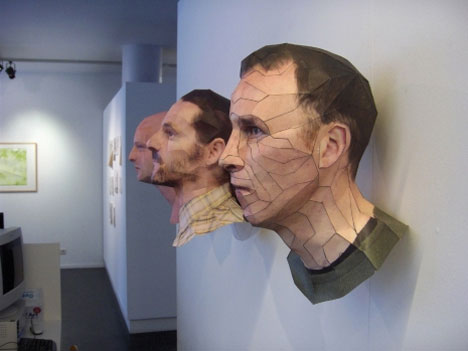
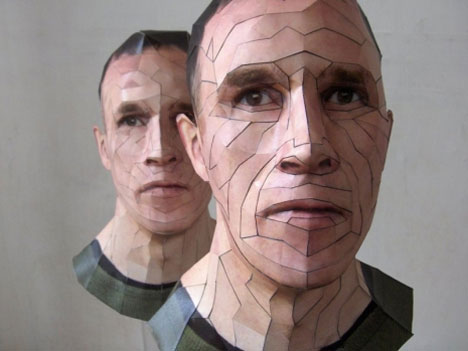
(images via: BertSimons.com)
Eerie, faceted 3-D paper heads float on a wall like grotesque hunting trophies. They’re photo-realistic replicas of Rotterdam papercraft artist Burt Simons and his friends, created when Simons had a ‘mid-life crisis’ in 2006 and realized there wasn’t much of him that would be left behind. So, Simons decided to ‘clone himself’, sculpting his head in 3D and using photographs to texture it. He uses a computer program to flatten out the head into printable pieces of paper and then assembles them with glue. Simons says having his clones around helped him “get used to his bald spot”.
Haruki Nakamura - Moving Parts Paper Sculptures
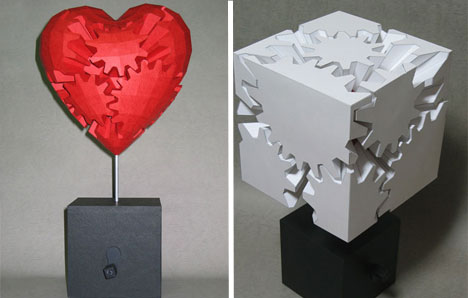
(images via: Paper Engineering Kamikara)
Haruki Nakamura’s papercraft does more than just sit there and look pretty. The pieces fit together like gears, and actually turn for a kinetic effect that goes far beyond most papercraft creations. Skip to the 49 second mark on the video to see his papercraft heart in action.
Eric Joisel - Detailed Classic Monster Figures
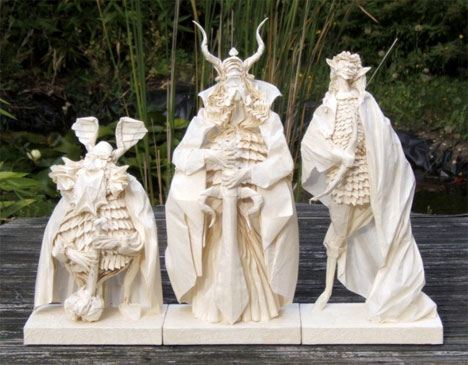
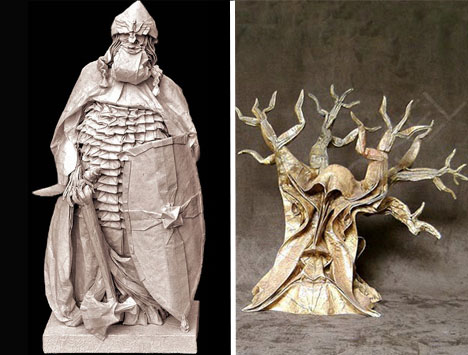
(images via: EricJoisel.com)
There’s a simple difference between mere papercraft and origami: the traditional concept of origami uses only once piece of paper with no cuts or glue. Eric Joisel is one modern origami artist that creates incredibly complex paper sculptures using blueprints that take him literally years to complete. Joisel says the creation process is like a scientific method, with creatures from myths and legends – like dwarves, fairies, hobbits and mermaids – popping up from his ‘crease patterns’.
Brian Chan - Elegantly Crafted Insect Sculptures
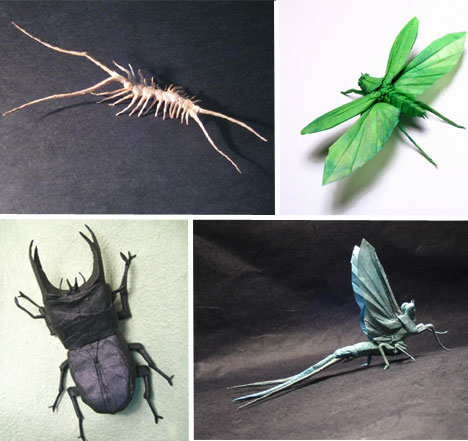
(images via: Origami by Brian Chan)
Brian Chan has been creating origami since elementary school, so it’s not too surprising that his work has evolved to the point of winning Best Original Design in the MIT origami competition. The MIT student finds the geometry aspect of origami folding to be especially rewarding. His portfolio of creations includes lots of insects, like the centipede, stag beetle, katydid and pictured above, as well as comic book and anime characters.
Brian Dettmer - Amazingly Complex Paper Cuts
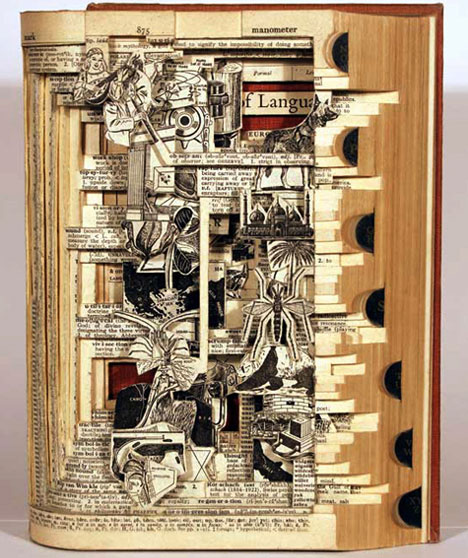
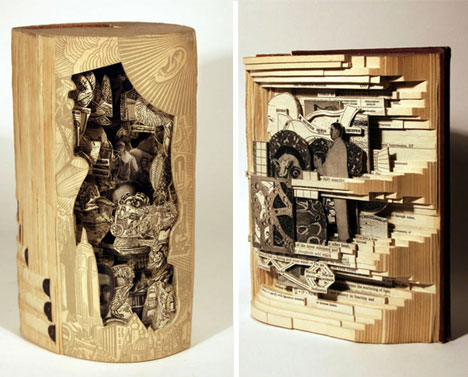
(images via: Centripetal Notion)
When it comes to reusing old books, Brian Dettmer has perhaps one of the most creative ideas ever: he turns them into fascinating carved sculptures called ‘Book Autopsies’ that transform them from dust collectors to fine art. Dettmer’s work goes beyond the simple concept of carving the pages of a book into a shape. The paper is cut to reveal certain words and images, for a shadow box-like effect.
Ingrid Siliakus - Detailed Architectural Masterpieces
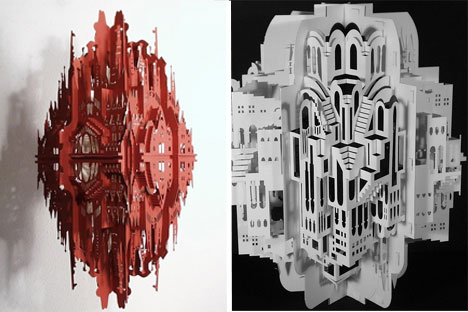
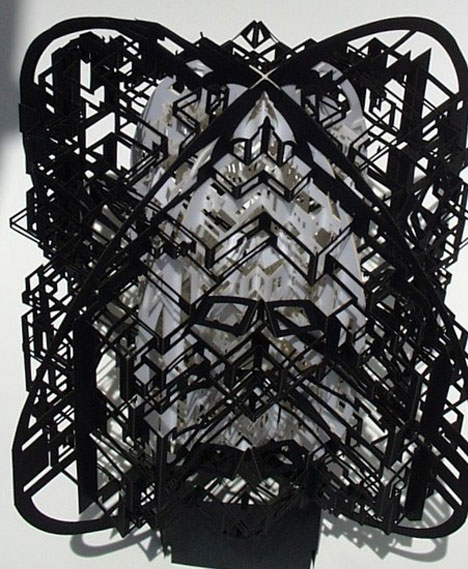
(images via: Ingrid-Siliakus.Exto.org)
Dutch paper artist Ingrid Siliakus deems her work ‘paper architecture’, and it’s a fitting description. Siliakus builds paper recreations of buildings made by master architects as well as her own abstract sculptures. She draws inspiration from sources like artist M.C. Escher and architect and paper sculptor Masahiro Chatani, whose work inspired her to try her hand at 3-D paper sculpture.
Sher Christopher - Emotive Paper Figurines


(images via: SherChristopher.com)
Sculptor Sher Christopher’s creations look like characters in a play, replete with theatrical masks, hats and intricate costumes. Christopher gathers papers of various colors and textures from around the world, using the weight and feel of a sheet of paper to suggest the fluid flow of a gown or a wisp of hair. Christopher’s sculptures are characterized by unexpected attention to detail, such as an embossed belt barely visible under the folds of a coat.
Peter Callesen - Playful Seasonal Paper Sculptures
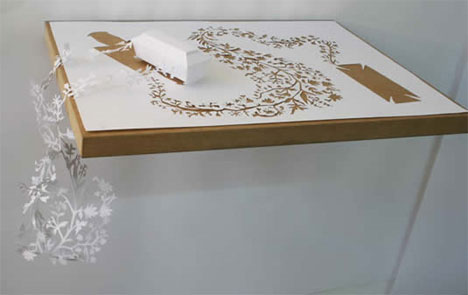

(images via: PeterCalleson.com)
The bulk of Peter Calleson’s work is made from plain white sheets of A4 paper, chosen for the symbolism as well as the color and size. “By taking away all the information and starting from scratch using the blank white A4 paper sheet for my creations, I feel I have found a material that we are all able to relate to, and at the same time the A4 paper sheet is neutral and open to fill with different meaning. The thin white paper gives the paper sculptures a frailty that underlines the tragic and romantic theme of my works.”
Elsa Mora - Variegated Detailed Paper Trinkets
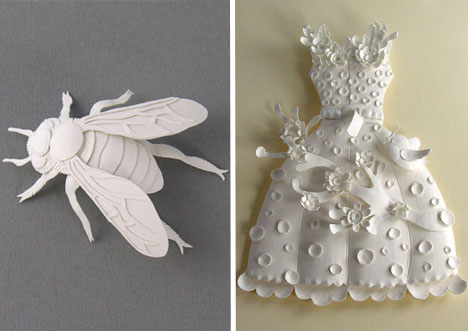
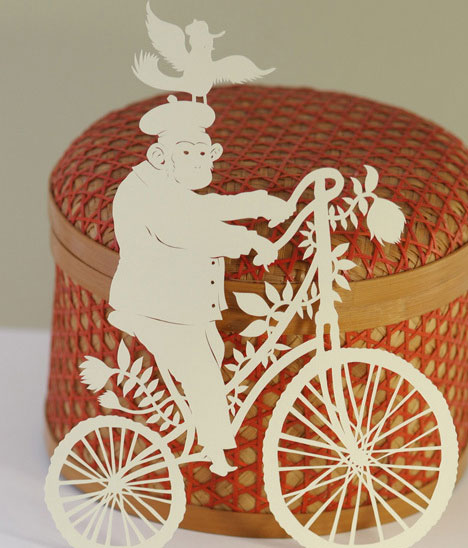
(images via: Elsita.typepad.com)
The whimsical paper art of Elsa Mora has a folkloric quality rooted in the artist’s childhood in Cuba. Carefully crafted flowers, branches and swirling graphical elements give Mora’s work a fun and free-spirited feel. Using scissors and an Xacto knife, Mora creates both paper silhouettes and 3-D sculptures of subjects like woodland creatures, little girls and monkeys riding bicycles.
Su Blackwell - Storybook Paper Works of Art

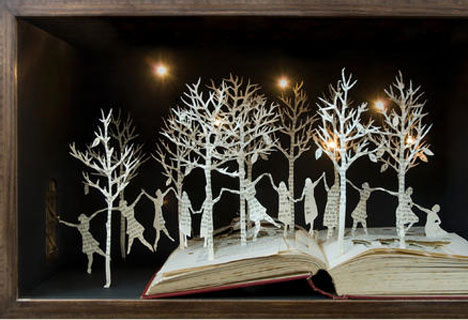
(images via: SuBlackwell.co.uk)
British paper sculptor Su Blackwell uses the delicacy of paper to make a statement in her work, saying “It is the delicacy, the slight feeling of claustrophobia, as if these characters, the landscape have been trapped inside the book all this time and are now suddenly released. A number of the compositions have an urgency about them, the choices made for the cut-out people from the illustrations seem to lean towards people on their way somewhere, about to discover something, or perhaps escaping from something. And the landscapes speak of a bleak mystery, a rising, an awareness of the air.”
Annie Vought - Abstract and Concrete Paper Art
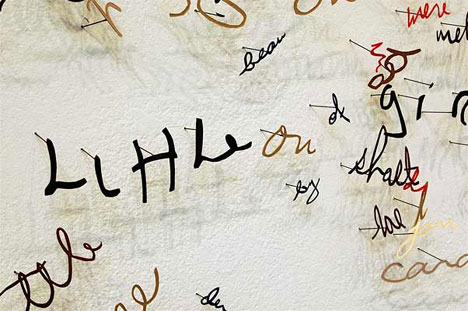
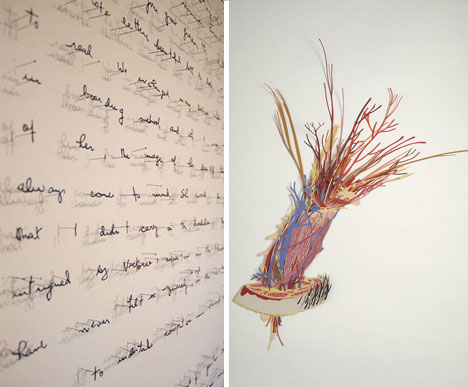
(images via: AnnieVought.com)
Annie Vought uses paper cutting to make statements that pop right off the wall – literally. Her 2006 paper art series utilized words cut from paper with extreme care, attached to a wall with delicate pins. It ranges from the childish scrawl of a student being punished with writing lines to a Christmas letter in elegant script. Vought also creates paper cut imagery such as oddly beautiful depictions of human veins.
Shin Tanaka - Adult Skills with Childlike Joy


(images via: Ping Mag + Shin.co.nr)
Japanese artist Shin Tanaka creates paper toys with a look that is clearly influenced by urban street art and culture. Tanaka’s designs can be downloaded as a PDF so you can print, cut and build your own versions of these playful creations. Tanaka was inspired to create these little guys when making plastic toys proved to be too costly, and he realized that creating and publishing paper toys was practically free. Shin began making paper models of sneakers he admired by couldn’t afford, which led to a display in a showcase of the NIKE design library as well as design collaborations with major shoe brands like Adidas.
Mark Sky - Magically Transformed Paper Money

(images via: The Dollar Artist)
Mark Sky is known as the ‘Dollar Artist’ for a good reason: all of his origami creations are made from dollar bills. Sky folds money into paper sculptures – called ‘moneygami’ – with subjects ranging from farm animals to fire-breathing dragons. Sky uses the patterns on the dollar bills to signify facial features, like scrolls or the letter ‘O’ as eyes.
Richard Sweeney - Artfully Twisted Paper Sculptures
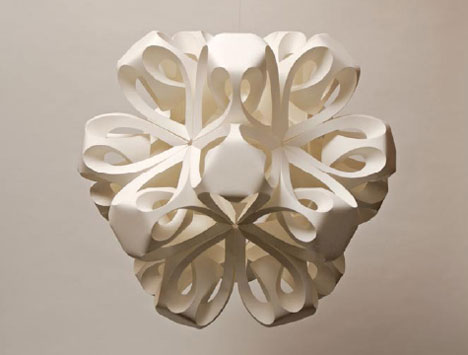
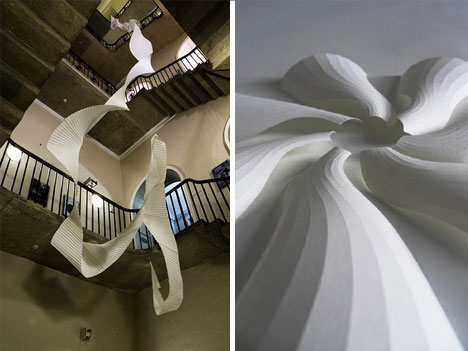
(images via: RichardSweeney.co.uk)
Richard Sweeney began using paper as a medium for sculpture when he realized that it was a great way to create form through hands-on material exploration. Of his work, Sweeney says “Discovering the properties of the medium in this direct way helped me better understand the potential of paper in its own right, leading to the creation of sculptural forms.”
Chris Natrop - Draped and Shadowed Paper Art
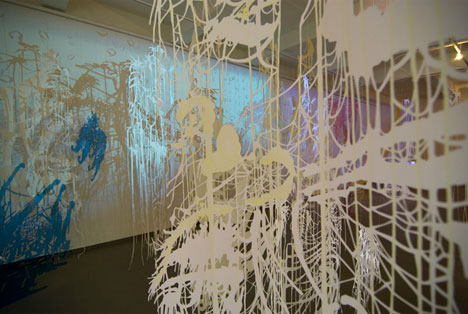

(images via: ChrisNatrop.com)
Chris Natrop’s papercraft art is perhaps best displayed as site-specific installation. Excited but a bit daunted by the challenges of the cavernous gallery space at MOCA Jacksonville, where his series entitled ‘And Further the Dewdrop Falls’ was to be exhibited, Natrop found inspiration in an unexpected place: the plane ride home after seeing the gallery in person for the first time. The view from the airplane window during a bout of turbulence compelled Natrop to want to “capture” atmosphere and infuse it into his work. As a result, his MOCA installation is inspired by the look and feel of mist and dewdrops.
Posted by gjblass at 2:13 PM 6 comments
Subscribe to:
Comments (Atom)











